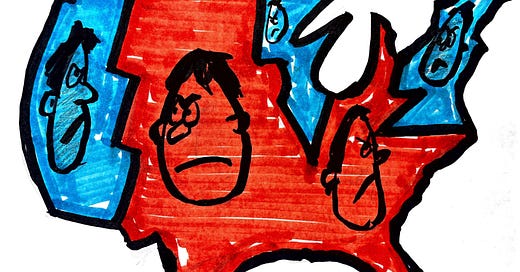The Supreme Court’s upcoming decision to reverse Roe v. Wade (an early draft of which was leaked Monday) doesn’t ban abortions; it leaves the issue to the states. As a result, it will put another large brick in the growing wall separating Blue and Red America.
Some say we’re on the verge of a civil war, but that’s not right. It won’t be a formal secession (we tried that once), but a kind of benign separation analogous to unhappily married people who don’t want to go through the trauma of a formal divorce. We are already quietly splitting into two Americas — one largely urban, racially and ethnically diverse, and young; the other largely rural or exurban, white, and older — each running according to different laws and with different sources of revenue.
The split is accelerating. Red ZIP codes are getting redder and blue ZIP codes, bluer. Of the nation's total 3,143 counties, the number of super landslide counties — where a presidential candidate won at least 80 percent of the vote — jumped from 6 percent in 2004 to 22 percent in 2020.
Surveys show Americans find it increasingly important to live around people who share their political values. Animosity toward those in the opposing party is higher than at any time in living memory. 42 percent of registered voters believe Americans in the other party are “downright evil.” Almost 40 percent would be upset at the prospect of their child marrying someone from the opposite party. Even before the 2020 election, when asked if violence would be justified if the other party won the election, 18.3 percent of Democrats and 13.8 percent of Republicans responded in the affirmative.
While Red states make it nearly impossible to get abortions, they’re making it easier than ever to buy guns — even easier to carry concealed guns without a permit. They’re suppressing votes. (In Florida and Texas, teams of “election police” have been created to crack down on the rare crime of voter fraud, another fallout from Trump’s Big Lie.) They’re banning the teaching of America’s history of racism. They’re requiring transgender students to use bathrooms and join sports teams that reflect their gender at birth. They’re making it harder to protest; more difficult to qualify for unemployment benefits or other forms of public assistance; and almost impossible to form labor unions. And they’re passing “bounty” laws — enforced not by governments, which can be sued in federal court, but by rewards to private citizens for filing lawsuits — on issues ranging from classroom speech to abortions to vaccinations.
Blue states are moving in the opposite direction. Several, including Colorado and Vermont, are codifying a right to abortion. Some are helping cover abortion expenses for out-of-staters. When Idaho proposed a ban on abortions that empowers relatives to sue anyone who helps terminate a pregnancy after six weeks, nearby Oregon approved $15 million to help cover the abortion expenses of patients from other states. Maryland and Washington have expanded access and legal protections to out-of-state abortion patients. One package of pending California bills would expand access to California abortions and protect abortion providers from out-of-state legal action.
After the governor of Texas ordered state agencies to investigate parents for child abuse if they provide certain medical treatments to their transgender children, California lawmakers proposed making the state a refuge for transgender youths and their families. Another California proposal would thwart enforcement of out-of-state court judgments removing children from the custody of parents who get them gender-affirming health services. California is also about to enforce a ban on ghost guns and assault weapons with a California version of Texas’ recent six-week ban on abortion, featuring $10,000 bounties to encourage lawsuits from private citizens against anyone who sells, distributes or manufactures those types of firearms.
The new separation extends even to government revenue. A little-noticed trend is toward a growing share of total government taxing and spending occurring in the states — thereby making Blue states (which are overall wealthier than Red states) more financially autonomous.
For years, the inhabitants of Blue states have been sending more tax dollars to the federal government than they get back (in the form of federal assistance to the poor, education, social services, and infrastructure), while Red states have been sending Washington fewer dollars than they receive back. But the significance of this Blue state subsidy to Red states is declining as an ever-larger percentage of total federal and state taxes paid by the inhabitants of Blue states are being spent in such Blue States. (A record half of all government revenue is now raised and spent by state and local governments.)
We’re also seeing more coordination among Blue states. During the pandemic, Blue states joined together on policies that Red states rejected — such as purchasing agreements for personal protective equipment, strategies for reopening businesses as COVID subsided, even on travel from other states with high levels of COVID. (At one point, New York, New Jersey, and Connecticut required travelers from states with high positivity rates — Arkansas, Florida, North and South Carolina, Texas, and Utah — to quarantine for two weeks before entering.)
We are splitting more quickly than anyone imagined. But the split raises a host of questions. For one, what will happen to the poor in Red states, who are disproportionately people of color? “States rights” was always a cover for segregation and harsh discrimination. The poor — both white and people of color — are already especially burdened by anti-abortion legislation because they can’t afford travel to a Blue state to get an abortion. They’re also hurt by the failure of Red states to expand Medicaid eligibility under the Affordable Care Act; by Red state de facto segregation in public schools; and by Red state measures to suppress votes.
One answer is for Democratic administrations and congresses in Washington to prioritize the needs of the Red state poor and make extra efforts to protect the civil and political rights of people of color in Red states. The failure of the Senate to muster enough votes to pass the Freedom to Vote Act, let alone revive the Voting Rights Act, suggests how difficult this will be.
But Blue states have a potential role here. They should spend additional resources on the needs of Red state residents, such as Oregon is now doing for people from outside Oregon who seek abortions. They should prohibit state funds from being spent in any state that bans abortions or discriminates on the basis of race, ethnicity, or gender. California already bars anyone on a state payroll (including yours truly, who teaches at UC Berkeley) from getting reimbursed for travel to states that discriminate against LGBTQ people (as of now, that list includes Alabama, Arkansas, Florida, Idaho, Iowa, Kansas, Kentucky, Mississippi, Montana, North Carolina, South Carolina, North Dakota, South Dakota, Ohio, Oklahoma, Tennessee, Texas, and West Virginia).
Where will all this end? Not with two separate nations. What America is going through is less like a civil war and more like Brexit — a lumbering, mutual decision to go separate ways on most things but remain connected on a few big things (such as national defense, monetary policy, and civil and political rights). We’ll still be America. But we’re becoming two versions of America. The open question is analogous to the one faced by every couple that separates — how will we find ways to be civil toward each other?
























Share this post